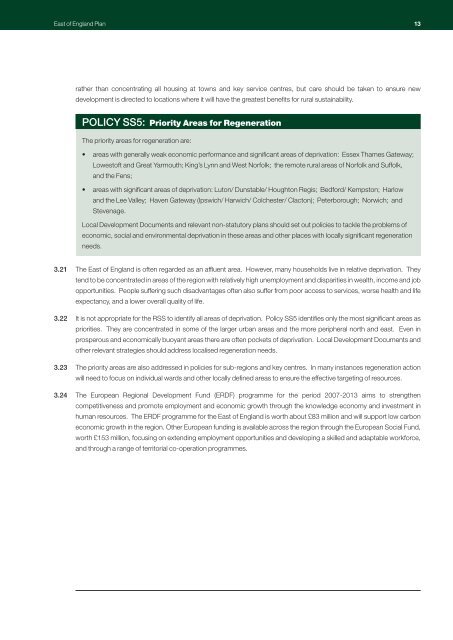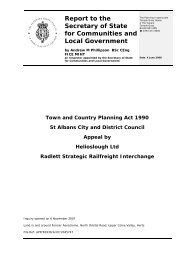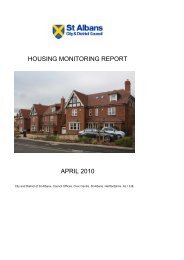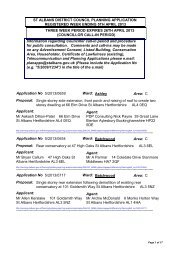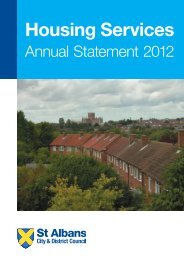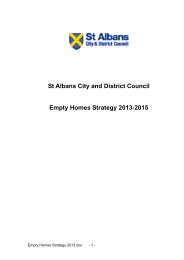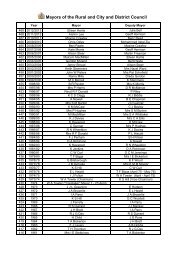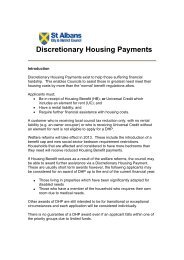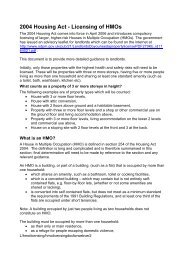RSS East Of England Plan - Broads Authority
RSS East Of England Plan - Broads Authority
RSS East Of England Plan - Broads Authority
Create successful ePaper yourself
Turn your PDF publications into a flip-book with our unique Google optimized e-Paper software.
<strong>East</strong> of <strong>England</strong> <strong>Plan</strong> 13<br />
rather than concentrating all housing at towns and key service centres, but care should be taken to ensure new<br />
development is directed to locations where it will have the greatest benefits for rural sustainability.<br />
POLICY SS5: Priority Areas for Regeneration<br />
The priority areas for regeneration are:<br />
• areas with generally weak economic performance and significant areas of deprivation: Essex Thames Gateway;<br />
Lowestoft and Great Yarmouth; King’s Lynn and West Norfolk; the remote rural areas of Norfolk and Suffolk,<br />
and the Fens;<br />
• areas with significant areas of deprivation: Luton/ Dunstable/ Houghton Regis; Bedford/ Kempston; Harlow<br />
and the Lee Valley; Haven Gateway (Ipswich/ Harwich/ Colchester/ Clacton); Peterborough; Norwich; and<br />
Stevenage.<br />
Local Development Documents and relevant non-statutory plans should set out policies to tackle the problems of<br />
economic, social and environmental deprivation in these areas and other places with locally significant regeneration<br />
needs.<br />
3.21 The <strong>East</strong> of <strong>England</strong> is often regarded as an affluent area. However, many households live in relative deprivation. They<br />
tend to be concentrated in areas of the region with relatively high unemployment and disparities in wealth, income and job<br />
opportunities. People suffering such disadvantages often also suffer from poor access to services, worse health and life<br />
expectancy, and a lower overall quality of life.<br />
3.22 It is not appropriate for the <strong>RSS</strong> to identify all areas of deprivation. Policy SS5 identifies only the most significant areas as<br />
priorities. They are concentrated in some of the larger urban areas and the more peripheral north and east. Even in<br />
prosperous and economically buoyant areas there are often pockets of deprivation. Local Development Documents and<br />
other relevant strategies should address localised regeneration needs.<br />
3.23 The priority areas are also addressed in policies for sub-regions and key centres. In many instances regeneration action<br />
will need to focus on individual wards and other locally defined areas to ensure the effective targeting of resources.<br />
3.24 The European Regional Development Fund (ERDF) programme for the period 2007-2013 aims to strengthen<br />
competitiveness and promote employment and economic growth through the knowledge economy and investment in<br />
human resources. The ERDF programme for the <strong>East</strong> of <strong>England</strong> is worth about £83 million and will support low carbon<br />
economic growth in the region. Other European funding is available across the region through the European Social Fund,<br />
worth £153 million, focusing on extending employment opportunities and developing a skilled and adaptable workforce,<br />
and through a range of territorial co-operation programmes.


